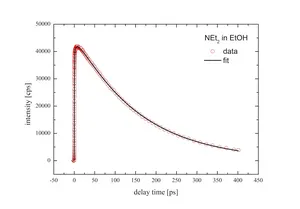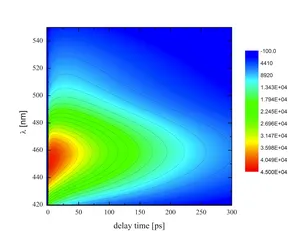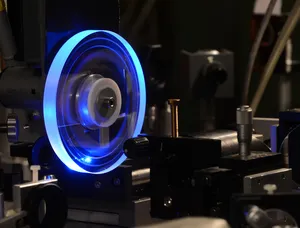Fluorescence Spectroscopy
Fluorescence upconversion is a technique to resolve ultrafast excited state dynamics of dyes or other organic molecules, which occurs on time scales of some 100 femtoseconds up to nanoseconds. For this, a predesigned Ti:Sa laser oscillator produces ultrashort pulses with a duration of 50 fs with a repetition rate of 5 MHz and an energy of approximately 200 µJ. The second harmonic with a central wavelength of 400 nm is generated by a nonlinear process in a BBO crystal in order to excite the molecules to a higher excited state. The emitted fluorescence signal is overlapped with a gate-pulse (800 nm) in a second crystal and the resulting sum frequency is detected wavelength-resolved with a monochromator and a single photon counter. Variable delay of the gate pulse leads to temporal resolution of the fluorescence signal, which is limited by the cross correlation of pump- and gate-pulse.
The investigated samples contain conjugated systems (double bonds or π-bonds), which are excited to an electronic excited state through absorption of a pump photon. After a cascade of vibrational relaxations and radiation-free processes (proton transfer reactions, solvent relaxation, twisting of functional groups in the excited state,...) the system descends to the electronic ground state emitting a fluorescence photon.
Alltogether, the molecule and its closest environment (solvent) is probed, which leads to a fluorescence signal that can be described by a sum of different exponential decaying states, which occur intra- and intermolecular on different timescales. Decay times, transient spectra, anisotropy and more characteristic variables of organic molecules, which are used as DNA-markers and protein-markers in fluorescence microscopy, can be derived from these data with high precision. One big advantage of this technique is that fluorescence upconversion is in contrast to pump-probe-techniques not dependent on the wavepacket dynamics and the vibronic structure of the electronic ground state and therefore dynamics of the excited state can be investigated directly.


